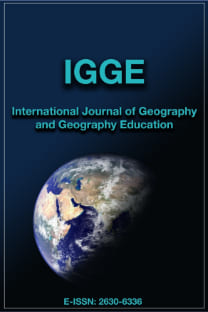KURULUŞ YERİ SEÇİMİNDE ULAŞIMIN ETKİLİ OLDUĞU YERLEŞMELERE BİR ÖRNEK: YENİÇUBUK KASABASI (GEMEREK-SİVAS)
Yeniçubuk, ulaşım, göçmen nüfus, Yeniçubuk istasyonu
-
Yeniçubuk, transportation, immigrant population, Yeniçubuk station,
___
- Başıbüyük, A., (2006). “Demiryoluna Bağlı Olarak Kurulan Bir İlçe Merkezi: İliç (Erzincan)” Doğu Coğrafya Dergisi, sayı 15, s.251-274, Erzurum.
- Bıyık, A., (2008). Gemerek Kasaba ve Köyleri (Tarihi ve Tarihi Yerleri), Berikan Yayınevi, Ankara.
- Bozkaya, Ö., Yalçın, H., ve Deniz, M., (2005). “Sivas Baseni’nin Gemerek Kesimindeki Miyosen Yaşlı Gölsel Kayaçların Kil Minerolojisi” 12. Ulusal Kil Sempozyumu 5-9 Eylül 2005, s.32-45, Van.
- Doğanay, H., ve Koca, H., (1998). “Ulaşımın Yerleşmeye Etkilerine İki Tipik Örnek: Fevzipaşa ve Nurdağı Kasabaları” Türk Coğrafya Dergisi 33: 1-24, İstanbul.
- Duygu, S., (1953). Yozgat Tarihi ve Çapanoğulları, Sayar Matbaası, İstanbul.
- Gök, Y., (2000). “Çevre Yollarının Erzurum Peyzajına Etkileri” Türk Coğrafya Dergisi, sayı 35, s.155-172, İstanbul.
- Gürsoy, C. R., (1975). “Türkiye’nin Tabii Yolları” Türk Coğrafya Dergisi, sayı 26, s.24-30, İstanbul.
- Karabulut, Y., (1997). “Türkiye’de Demiryolu Ulaşımı” Türkiye Coğrafyası Araştırma ve Uygulama Merkezi Dergisi, sayı 6, s.163-187, Ankara.
- Koç, Y., (2000). “Bozok Türkmenleri” Anadolu’da ve Rumeli’de Yörükler ve Türkmenler Sempozyumu Bildirileri Tarsus 14 Mayıs 2000, s.95-209, Ankara.
- Koç, Y., (1989). XV. Yüzyılda Bir Osmanlı Sancağının İskan ve Nüfus Yapısı (The population structure and processe of settlement in the province of Bozok in the XVIth century), Kültür Bakanlığı Yayınları, Ankara.
- Köse, A., (1996). Fonksiyonel Özellikleri Yönünden İvrindi, Atatürk Üniversitesi Yay. No:831, Kâzım Karabekir Eğitim Fakültesi Yay. No: 74, Araştırma Serisi No: 16, Erzurum.
- Kurtman, F., ve Akkuş, M, F., (1971). “Doğu Anadolu’daki Ara Basenler ve Bunların Petrol Olanakları” MTA Dergisi, sayı 77, s.1-9, Ankara.
- Mahiroğulları, A. M., (2003). İlk Çağlardan Günümüze Sivas İli, Kitap Matbaacılık, Sivas.
- Ökse, T., (2005). “Kızılırmak ve Fırat Havzalarını Birbirine Bağlayan Eski Kervan Yolları”, Bilig Dergisi, sayı 34, s.15-32.
- Öz, M., (2000). “Bozok Sancağında İskan ve Nüfus 1539-1642” XII. Türk Tarih Kongresi, Bildiriler Kitabı, cilt 3, s.787-794, Ankara.
- Öz, M., (2004). “Population Fall In Seventeenth Century Anatolia: Some Findings for the Districts of Canik and Bozok” Archivum Ottomanicum, Volume 22, s.159-171.
- Özgür, E. M., (1996). “Yeni İlçe Merkezlerimizin Fonksiyonel Açıdan Gösterdiği Özellikler”, Ankara Üniversitesi, D.T.C.F. Coğrafya Araştırmaları Dergisi, sayı 12, s.25-32, Ankara.
- Şahin, İ. F., (2007). "Belen Geçidinde Coğrafi Gözlemler" Doğu Coğrafya Dergisi, sayı 17, s.65-86, Erzurum.
- Tıraş, M., (2002). “Ulaşımın Yerleşmeye Etkisine Bir Örnek: Pozantı” Türk Coğrafya Dergisi, sayı 38, s.121-131, İstanbul.
- Tümertekin, E., (1987). Ulaşım Coğrafyası, İstanbul Üniversitesi Yayınları No:2053, Coğrafya Enstitüsü Yayınları No: 85, İstanbul.
- Tümertekin, E., ve Özgüç, N., (2005). Ekonomik Coğrafya, Çantay Kitabevi, İstanbul.
- Türkmen, İ., ve Kerey, E., (1994). “Gemerek (Sivas) Dolaylarında Formasyonunun Yeniçubuk Sedimantolojik Özellikleri” 47. Türkiye Jeoloji Kurultayı Bildiri Özetleri 21-24 Şubat 1994, s.77-78, Ankara.
- Türkmen, İ., ve Bölücek, C., (1998). “The Origin of Clay Minerals in Salina Playa-Mudflat Facies, Yeniçubuk Formation (Lower- Middle Miocene), Gemerek, Sivas, Türkiye” Turkish Journal of Earth Sciences, Volume 7, s.1-10.
- Yıldırım, T., (1998). “Doğu Kapadokya Bölgesi Yüzey Araştırmalarında Derlenen Seramikler” Ankara Üniversitesi DTCF Dergisi, sayı 38(1-2), s.249-270, Ankara.
- Yücel, T., (1960). “Demiryollarımızın İstasyon Nüfuslarına Etkisi” Türk Coğrafya Dergisi, sayı 20, s.143-148, İstanbul.
- http://www.kgm.gov.tr/Sayfalar/KGM/SiteTr/Istatistikler/TrafikveUlasi m.aspx son erişim 25 Mayıs 2013.
- www.yeniçubuk.bel.tr son erişim 30 Haziran 2013.
- www.gemerek.gov.tr son erişim 17 Temmuz 2013.
- www.sivas.gov.tr son erişim 22 Mayıs 2013.
- Yayın Aralığı: Yılda 3 Sayı
- Başlangıç: 1996
- Yayıncı: Marmara Üniversitesi
KÜLTÜREL MİRAS KAYNAĞI OLARAK KÖPRÜBAŞI İLÇESİNDE (TRABZON) GELENEKSEL TAHTA KAŞIK ÜRETİMİ
COĞRAFYA ÖĞRETMENLİĞİ YÜKSEK LİSANS PROGRAMI ÖĞRENCİLERİNİN YÜKSEK LİSANSTAN BEKLENTİLERİ
Hamza AKENGİN, Gülten YILDIRIM, Zafer İBRAHİMOĞLU, Seyfettin ARSLAN
COĞRAFİ BİLGİ SİSTEMLERİ’NİN (CBS) COĞRAFYA ÖĞRETİMİNDE KULLANIMININ ÖNEMİ VE GEREKLİLİĞİ
COĞRAFYA LİSANS ÖĞRENCİLERİNİN MEZUNİYET SONRASI KARİYER PLANLARINA İLİŞKİN GÖRÜŞLERİ
SOSYAL BİLGİLER ÖĞRETİMİNDE MÜZE GEZİLERİNİN TARİHİ VE KÜLTÜREL DEĞERLERİN KAZANDIRILMASINDAKİ ÖNEMİ
ISPARTA İLİ MİLLİ PARKLARININ REKREASYONEL FAALİYETLERDE KULLANIMI
İsmail KERVANKIRAN, Adile ERYILMAZ
KAMU HİZMETLERİNİN KENTSEL YAŞANABİLİRLİK ÜZERİNE ETKİSİ: BEYLİKDÜZÜ ÖRNEĞİ
Arif KEÇELİ, Faruk SARIUSTA, Mehmet KARAKUYU
